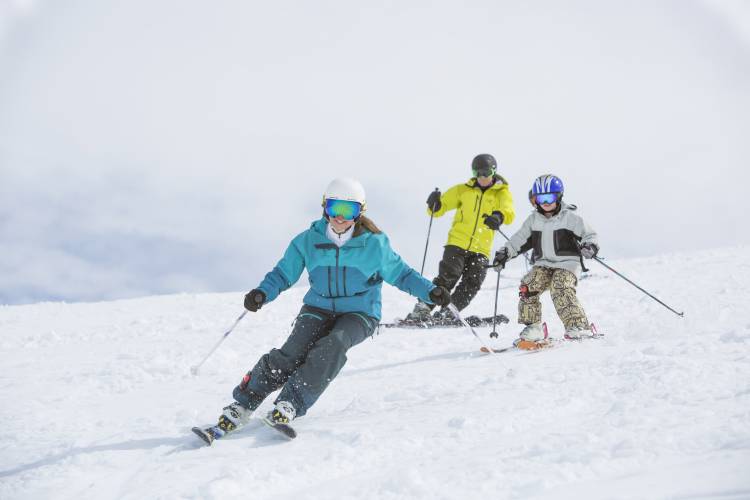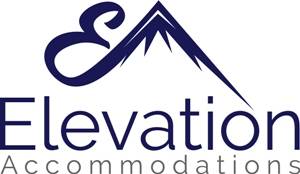8 Tips for Staying Safe on the Ski Slopes

There is no doubt that most visitors to Colorado during the winter are drawn to the myriad of winter sports and activities that our great state has to offer. Skiing the fresh powder of our beautiful mountains is perhaps the most popular and well known of those sports. As your vacation rental provider, one of Elevation Accommodations’ goals is to offer you information that will help keep you safe during your vacation. We have compiled these eight tips for Beaver Creek ski safety for you and your family to consider.
1. Common Sense and Personal Responsibility
Whether you are a seasoned professional or a ski novice, the most important safety tip for skiing is to use your head. Common sense and personal responsibility go a long way out on the slopes. Knowing your personal skill level and physical limitations, being observant, asking for help or instructions, staying aware of your surroundings, being familiar with your ski equipment, and doing as much research as possible ahead of time so you are prepared for your recreational adventures are just a few ways to be responsible.
Common sense would also tell you to refrain from the use of electronic devices or other distractions while skiing. Another simple thing to consider is that you should know and obey all posted signs. The staff and employees at ski resorts work hard to ensure you have a safe and fun experience. If they have closed a trail or marked a slow zone, it is your job to trust the signs and their intentions. It is also your responsibility to know the lift and slope operation times.
2. What’s the Weather Forecast
Those who are not familiar with Colorado winter weather patterns need to pay particular attention to weather conditions. Everyone should be aware of the weather forecast when they plan to be outdoors and ski. Is the day going to be clear, cold, and sunny? Is there a chance of freezing rain or white-out conditions? You will need to dress and plan accordingly. Know before you go! Click here for the Beaver Creek snow report.
3. Know the Code
Beaver Creek Resort and many other ski slopes share a common “Know the Code” principle for Colorado ski safety. This code of responsibility consists of:
- Always stay in control. You must be able to stop or avoid people or objects.
- People ahead or downhill of you have the right-of-way. You must avoid them.
- Stop only where you are visible from above and do not restrict traffic.
- Look uphill and avoid others before starting downhill or entering a trail.
- You must prevent runaway equipment.
- Read and obey all signs, warnings, and hazard markings.
- Keep off closed trails and out of closed areas.
- You must know how and be able to load, ride and unload lifts safely. If you need assistance, ask the lift attendant.
- Do not use lifts or terrain when impaired by alcohol or drugs.
- If you are involved in a collision or incident, share your contact information with each other and a ski area employee.
4. Trail Sign and Designation
Do you know the symbols and signs used for the slopes you will be skiing? Each resort and mountain can use a variety of symbols and signs to mark trails. From green circles to black diamonds, what do they mean? How do these signs apply to you?
Trail designations are for the safety and well-being of the people who are enjoying the mountainside. Not only is it important for you to familiarize yourself with trail maps, but it is also important to have a clear understanding of the unique trails and systems used on each mountain.
At Beaver Creek, there is a trail map created for each ski season. Please notice the key on the map that illustrates the different trail types, boundaries, special zones, the location of ski patrol, the three parks within Beaver Creek (Red Buffalo Park, Haymeadow Park, and McCoy Park), and the various bowls & terrain. If you are ever in doubt of where to begin or which trails are best suited for your skill level, please ask.
Other signs you may need to look out for are avalanche & backcountry warnings, closed terrains, and slow zones.
Be aware that there may also be obstacles that are unmarked.
5. Lift Safety
If you have watched much TikTok, then you have probably seen ski lift loading or unloading gone wrong. It looks simple enough, but there is room for error. There are several different kinds of ski lifts, each requiring a different skill set. If you are unsure how to enter a specific lift, watch and observe what others are doing. If it is your first time on a specific kind of lift or if you are nervous, let the attendant know and they will assist.
Watch this video to know how to get on and off a lift
6. Equipment & Gear
You are going to need some basic equipment when you are ready to hit the slopes. This safety tip for skiing outlines your list of equipment. Whether you are renting equipment or have your own, you must ensure that everything is in good working condition and that everything fits properly. When assembling what you are going to wear for a day on the mountain, remember that cotton gets wet and cold quickly and is not an appropriate fabric for skiing.
- Skis
- Poles
- Ski Boots
- Helmet (for warmth and head protection)
- Goggles (acts as eye protection and sunglasses)
- Sunscreen and Chapstick
- Next to Skin/Base Layer
- 2nd Layer/Insulating Layer
- Outer Shell for Upper Body
- Base Layer for Bottom
- Snow Pants or Bibs (for insulation and waterproofing)
- Tall Ski Socks (wear wool for warmth and wicking)
- Mittens or Gloves
- Neckwear
Watch this video to see what to pack for your ski vacation.
7. High-Altitude Environment
The summit of Beaver Creek Mountain sits at 11,440 feet above sea level. What does this high-altitude mean to you? It means that you may experience symptoms of altitude sickness such as headaches, nausea, difficulty breathing, sleeping issues, coughing, or a lack of appetite. Keep in mind that your body is used to the elevation of your normal environment, and this sudden change can affect your body. If symptoms persist or you are concerned about your heath, be sure to seek medical attention as soon as possible.
Something else to consider is that UV levels rise by 10%-12% with every 3,000 feet of increase in altitude. If you are taking your Beaver Creek ski safety seriously, you will wear sunscreen, lip protection, and eye protection. The proper use of sun-care products and eye protection will make a difference in your overall ski experience.
8. The Colorado Ski Safety Act
Last up on our list of tips is the Colorado Ski Safety Act. If you are planning a ski trip to Colorado, please be sure you have read through this important act. It was established to help maintain the highest levels of safety for those who participate in and provide ski sports in our state.
Now that you know how to enjoy a safe and fun ski trip, it is time to choose where you would like to stay. Browse through our selection of Beaver Creek vacation rentals and find one that is perfect for your next winter escape. From ski-in and ski-out accommodations to luxurious mountain homes, we have a rental to fit your vacation needs.
